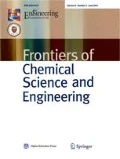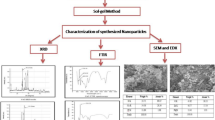Abstract
Focused beam reflectance measurement (FBRM) and 13C nuclear magnetic resonance (13C NMR) analysis were used to study the precipitation process of CO2-loaded potassium glycinate (KGLY) solutions at different CO2 loadings, during the addition of ethanol as an antisolvent at a rate of 10 mL·min−1. The volume ratio of ethanol added to the KGLY solution (3.0 mol·L−1, 340 mL) ranged from 0 to 3.0. Three solid-liquid-liquid phases were formed during the precipitation process. The FBRM results showed that the number of particles formed increased with CO2 loading and ethanol addition for CO2-unsaturated KGLY solutions, whilst for CO2-saturated KGLY solution it first increased then decreased to a stable value with ethanol addition. 13C NMR spectroscopic analysis showed that the crystals precipitated from the CO2-unsaturated KGLY solutions consisted of glycine only, and the quantity crystallised increased with CO2 loading and ethanol addition. However, a complex mixture containing glycine, carbamate and potassium bicarbonate was precipitated from CO2-saturated KGLY solution with the maximum precipitation percentages of 94.3%, 31.4% and 89.6%, respectively, at the ethanol volume fractions of 1.6, 2.5 and 2.3.

Similar content being viewed by others
References
Yang H, Xu Z, Fan M, Gupta R, Slimane R B, Bland A E, Wright I. Progress in carbon dioxide separation and capture: A review. Acta Scientiae Circumstantiae, 2008, 20(1): 14–27
Davison J, Thambimuthu K. An overview of technologies and costs of carbon dioxide capture in power generation. Proceedings of the Institution of Mechanical Engineers. Part A, Journal of Power and Energy, 2009, 223(3): 201–212
Jou F Y, Mather A E, Otto F D. The solubility of CO2 in a 30 mass% monoethanolamine solution. Canadian Journal of Chemical Engineering, 1995, 73(1): 140–147
Hook R J. An investigation of some sterically hindered amines as potential carbon dioxide scrubbing compounds. Industrial & Engineering Chemistry Research, 1997, 36(5): 1779–1790
Penny D E, Ritter T J. Kinetic study of the reaction between carbon dioxide and primary amines. Journal of the Chemical Society, Faraday Transactions, 1983, 9(9): 2103–2109
Rochelle G T. New amines for CO2 capture. II. Oxidative degradation mechanisms. Current Opinion in Chemical Engineering, 2012, 1(2): 183–190
Park D W, Son Y S, Park D W, Oh K J. Absorption of carbon dioxide into aqueous solution of sodium glycinate. Separation Science and Technology, 2008, 43(11–12): 3003–3019
Kumar P S, Hogendoorn J A, Versteeg G F, Feron P H M. Kinetics of the reaction of CO2 with aqueous potassium salt of taurine and glycine. AIChE Journal. American Institute of Chemical Engineers, 2010, 49(1): 203–213
Hu G, Smith K H, Liu L, Kentish S E, Stevens G W. Reaction kinetics and mechanism between histidine and carbon dioxide. Chemical Engineering Journal, 2017, 307(1): 56–62
Holst J V, Versteeg G F, Brilman D W F, Hogendoorn J A. Kinetic study of CO2 with various amino acid salts in aqueous solution. Chemical Engineering Science, 2009, 64(1): 59–68
Kumar P, Hogendoorn J, Versteeg G, Feron P. Kinetics of the reaction of CO2 with aqueous potassium salt of taurine and glycine. AIChE Journal. American Institute of Chemical Engineers, 2003, 49(1): 203–213
Portugal A F, Sousa J M, Magalhães F D, Mendes A. Solubility of carbon dioxide in aqueous solutions of amino acid salts. Chemical Engineering Science, 2009, 64(9): 1993–2002
Hallenbeck A P, Egbebi A, Resnik K P, Hopkinson D, Anna S L, Kitchin J R. Comparative microfluidic screening of amino acid salt solutions for post-combustion CO2 capture. International Journal of Greenhouse Gas Control, 2015, 43: 189–197
Lim J A, Kim D H, Yoon Y, Jeong S K, Park K T, Nam S C. Absorption of CO2 into aqueous potassium salt solutions of l-alanine and l-proline. Energy & Fuels, 2012, 26(6): 3910–3918
Majchrowicz M E, Brilman D W F. Solubility of CO2 in aqueous potassium l-prolinate solutions-absorber conditions. Chemical Engineering Science, 2012, 72: 35–44
Thee H, Nicholas N J, Smith K H, Da Silva G, Kentish S E, Stevens G W. A kinetic study of CO2 capture with potassium carbonate solutions promoted with various amino acids: Glycine, sarcosine and proline. International Journal of Greenhouse Gas Control, 2014, 20(Suppl C): 212–222
Fernandez E S, Heffernan K, Ham L V V D, Linders M J G, Eggink E, Schrama F N H, Brilman D W F, Goetheer E L V, Vlugt T J H. Conceptual design of a novel CO2 capture process based on precipitating amino acid solvents. Industrial & Engineering Chemistry Research, 2013, 52(34): 12223–12235
Perry R J, Wood B R, Genovese S, O’Brien M J, Westendorf T, Meketa M L, Farnum R, Mcdermott J, Sultanova I, Perry T M, et al. CO2 capture using phase-changing sorbents. Energy & Fuels, 2012, 26(4): 2528–2538
Seo S, Simoni L D, Ma M, Desilva M A, Huang Y, Stadtherr M A, Brennecke J F. Phase-change ionic liquids for postcombustion CO2 capture. Energy & Fuels, 2014, 28(9): 5968–5977
Wang L D, An S L, Li Q W, Yu S H, Wu S Y. Phase change behavior and kinetics of CO2 absorption into DMBA/DEEA solution in a wetted-wall column. Chemical Engineering Journal, 2017, 314: 681–687
Kumar P S, Hogendoorn J A, Feron P H M, Versteeg G F. Equilibrium solubility of CO2 in aqueous potassium taurate solutions: Part 1. Crystallization in carbon dioxide loaded aqueous salt solutions of amino acids. Industrial & Engineering Chemistry Research, 2003, 42(12): 2832–2840
Fernandez E S, Goetheer E L V. DECAB: Process development of a phase change absorption process. Energy Procedia, 2011, 4(1): 868–875
Aronu U E, Ciftja A F, Kim I, Hartono A. Understanding precipitation in amino acid salt systems at process conditions. Energy Procedia, 2013, 37: 233–240
Bian Y Y, Shen S F. CO2 absorption into a phase change absorbent: Water-lean potassium prolinate/ethanol solution. Chinese Journal of Chemical Engineering, 2018, 26(11): 2318–2326
Holmes P E, Naaz M, Poling B E. Ion Concentrations in the CO2-NH3-H2O system from 13C NMR spectroscopy. Industrial & Engineering Chemistry Research, 1998, 37(8): 3281–3287
Shi H C, Naami A, Idem R, Sema T, Liang Z W, Usubharatana P, Saiwan C, Tontiwachwuthikul P. NMR analysis of amine-CO2-H2O systems with VLE modeling for CO2 capture processes. Future Medicinal Chemistry, 2013, 10: 10–31
Shi H, Sema T, Naami A, Liang Z, Idem R, Tontiwachwuthikul P. 13C NMR spectroscopy of a novel amine species in the DEAB—CO2-H2O system: VLE model. Industrial & Engineering Chemistry Research, 2012, 51(25): 8608–8615
Acknowledgements
The authors acknowledge the infrastructure support from the Particulate Fluids Processing Centre (PFPC), the Peter Cook Centre (PCC) for Carbon Capture and Storage (CCS).
Author information
Authors and Affiliations
Corresponding authors
Electronic Supplementary Material
Rights and permissions
About this article
Cite this article
Chen, S., Wu, Y., Stevens, G.W. et al. Precipitation study of CO2-loaded glycinate solution with the introduction of ethanol as an antisolvent. Front. Chem. Sci. Eng. 14, 415–424 (2020). https://doi.org/10.1007/s11705-019-1882-4
Received:
Accepted:
Published:
Issue Date:
DOI: https://doi.org/10.1007/s11705-019-1882-4




